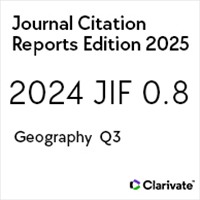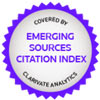Dinámica del consumo de gasolina en Ciudad Juárez, Chihuahua.
The fuel consumption increase in Ciudad Juarez, Chihuahua
https://doi.org/10.21670/ref.2012.26.a04
Palabras clave:
consumo de gasolina, economía fronterizaResumen
Este estudio analiza la dinámica del consumo de la gasolina en la economía metropolitana de Ciudad Juárez, Chihuahua, México. El análisis se lleva a cabo con la estimación de parámetros con la metodología de funciones de transferencia lineales arima. Este mercado es de interés ya que se observan influencias de condiciones económicas regionales, nacionales e internacionales. Variables que resultan significativas incluyen el precio real de la gasolina en Ciudad Juárez, el precio de la gasolina en Ciudad Juárez en relación con el precio de El Paso, Texas, EE.UU., y el empleo en Ciudad Juárez. Simulaciones fuera de muestra indican que el modelo es relativamente preciso en las proyecciones de uno a 24 meses de longitudAbstract This research analyzes short–run gasoline consumption dynamics in Ciudad Juárez, Chihuahua, México. Parameter estimation is carried out using linear transfer function arima analysis. This market is of interest because it is influenced by regional, national, and international economic conditions due to its location on the border with the United States. Explanatory variables that satisfy the significance criterion include the real price of gasoline in Ciudad Juárez, the price of gasoline in Ciudad Juárez relative to that charged across the border in el Paso, Texas, USA, and formal sector employment in Ciudad Juárez. Out–of–sample simulations indicate that the model is relatively accurate for forecasts of to 1 to 24 months into the future.
Citas
Alves, D.C.O. (2003), “Short-Run, Long-Run, and Cross Elasticities of Gasoline Demand in Brazil”, Energy Economics, núm. 25, pp. 191-199. DOI: https://doi.org/10.1016/S0140-9883(02)00108-1
Ayala, E. y L. Gutiérrez (2004), “Distorsiones de la política de precios de la gasolina en la frontera norte de México”, Comercio Exterior, núm. 54, pp. 704-711.
Banfi, S., M. Filippini y L.C. Hunt (2005), “Fuel Tourism in Border Regions: The Case of Switzerland”, Energy Economics, núm. 27, pp. 689-707. DOI: https://doi.org/10.1016/j.eneco.2005.04.006
Bauer, M., E. Mar y A. Elizalde (2003), “Transport and Energy Demand in Mexico: The Personal Income Shock”, Energy Policy, núm. 31, pp. 1475-1480. DOI: https://doi.org/10.1016/S0301-4215(02)00203-3
Blanco, L. y T.M. Fullerton Jr. (2006), “Borderplex Menu Evidence for the Law of One Price”, Economics Letters, núm. 90, pp. 28-33. DOI: https://doi.org/10.1016/j.econlet.2005.04.005
Blum, U.C.H., G. Foos y M. Gaudry (1988), “Aggregate Time Series Gasoline Demand Models: Review of the Literature and New Evidence for West Germany”, Transportation Research A – Policy and Practice, núm. 22, pp. 75-88. DOI: https://doi.org/10.1016/0191-2607(88)90020-9
Brons, M., P. Nijkamp, E. Pels y P. Rietveld (2008), “A Meta-Analysis of the Price Elasticity of Gasoline Demand: A SUR Approach”, Energy Economics, núm. 30, pp. 2105-2122. DOI: https://doi.org/10.1016/j.eneco.2007.08.004
Crotte, A., R.B. Noland y D.J. Graham (2010), “An Analysis of Gasoline Demand Elasticities at the National and Local Levels in Mexico”, Energy Policy, núm. 38, pp. 4445-4456. DOI: https://doi.org/10.1016/j.enpol.2010.03.076
Dahl, C. y T. Sterner (1991), “Analyzing Gasoline Demand Elasticities: A Survey”, Energy Economics, núm. 13, pp. 203-210. DOI: https://doi.org/10.1016/0140-9883(91)90021-Q
De Leon, M., T.M. Fullerton Jr. y B.W. Kelley (2009), “Tolls, Exchange Rates, and Borderplex International Bridge Traffic”, International Journal of Transport Economics, núm. 36, pp. 223-259.
Drollas, L. (1984), “The Demand for Gasoline: Further Evidence”, Energy Economics, núm. 6, pp. 71-82. DOI: https://doi.org/10.1016/0140-9883(84)90046-X
Eskeland, G.S. (1994), “A Presumptive Pigouvian Tax-Complementing Regulation to Mimic an Emissions Fee”, World Bank Economic Review, núm. 8, pp. 373- 394. DOI: https://doi.org/10.1093/wber/8.3.373
Eskeland, G.S. y T. Feyzioglu (1997), “Is Demand for Polluting Goods Manageable? An Econometric Study of Car Ownership and Use for Mexico”, Journal of Development Economics, núm. 6, pp. 71-82. DOI: https://doi.org/10.1016/S0304-3878(97)00017-5
Fullerton, T.M. Jr. (2007), “Empirical Evidence regarding 9/11 Impacts on the Borderplex Economy”, Regional & Sectoral Economic Studies, núm. 7, juliodiciembre, pp. 51-64.
——, R.L. Sprinkle y R. Tinajero (2003), “Flujos comerciales transfronterizos en el Distrito Aduanal de El Paso”, Comercio Exterior, núm. 53, pp. 1106-1110.
——, R. Tinajero y M. P. Barraza (2006), “Short-Term Water Consumption Patterns in Ciudad Juarez, Mexico”, Atlantic Economic Journal, núm. 34, pp. 467-479. DOI: https://doi.org/10.1007/s11293-006-9031-0
Haro, R. A. y J. L. Ibarrola (1999), “Cálculo de la elasticidad precio demanda de la gasolina en la zona fronteriza del norte de México”, Gaceta de Economía, núm. 6, pp. 237-264.
Ibarra, J.A. y L. Sotres (2008), “La demanda de gasolina en México: el efecto en la frontera norte”, Frontera Norte, núm. 20, enero-junio, pp. 131-156.
Iwayemi, A., A. Adenikinju y M. A. Babatunde (2010), “Estimating Petroleum Products Demand Elasticities in Nigeria”, Energy Economics, núm. 32, pp. 73- 85. DOI: https://doi.org/10.1016/j.eneco.2009.05.002
Karathodorou, N., D. J. Graham y R. B. Noland (2010), “Estimating the Effect of Urban Density on Fuel Demand”, Energy Economics, núm. 32, pp. 86-92. DOI: https://doi.org/10.1016/j.eneco.2009.05.005
Koshal, R. J., M. Koshal, Y. Yamada, S. Miyazima y K. Yamamoto (2007), “Demand for Gasoline in Japan”, International Journal of Transport Economics, núm. 34, pp. 351-367.
Leal, A., J. López-Laborda y F. Rodrigo (2009), “Prices, Taxes, and Automotive Fuel Cross-Border Shopping”, Energy Economics, núm. 31, pp. 225-234. DOI: https://doi.org/10.1016/j.eneco.2008.09.007
Lin, A.L., E.N. Botsas y S.A. Monroe (1985), “State Gasoline Consumption in the USA – An Econometric Analysis”, Energy Economics, núm. 7, pp. 29-36. DOI: https://doi.org/10.1016/0140-9883(85)90036-2
Manzan, S. y D. Zerom (2010), “A Semi-Parametric Analysis of Gasoline Demand in the United States”, Econometric Reviews, núm. 29, pp. 439-468. DOI: https://doi.org/10.1080/07474930903562320
Nicol, C. J. (2003), “Elasticities of Demand for Gasoline in Canada and United States”, Energy Economics, núm. 25, pp. 201-214. DOI: https://doi.org/10.1016/S0140-9883(03)00002-1
Parry, I.W.H. y G.R.Trimilsina (2010), “How should Passenger Travel in Mexico City be Priced?”, Journal of Urban Economics, núm. 68, pp. 167-182. DOI: https://doi.org/10.1016/j.jue.2010.03.009
Pindyck, R. S. y D. L. Rubinfeld (2001), Econometría: modelos y pronósticos, 4ª. ed., México, McGraw-Hill Interamericana.
Pock, M. (2010), “Gasoline Demand in Europe: New Insights”, Energy Economics, núm. 32, pp. 54-62. DOI: https://doi.org/10.1016/j.eneco.2009.04.002
Ramanathan, R. (1999), “Short and Long-Run Elasticities of Gasoline Demand in India: An Empirical Analysis Using Cointegration Techniques”, Energy Economics, núm. 21, pp. 321-330. DOI: https://doi.org/10.1016/S0140-9883(99)00011-0
Reyes, M. L y L. Blanco (2008), “Measuring the Importance of Oil-Related Revenues in Total Fiscal Income for Mexico”, Energy Economics, núm. 30, pp. 2552-2568. DOI: https://doi.org/10.1016/j.eneco.2008.02.001
Sa’ad, S. (2009), “An Empirical Analysis of Petroleum Demand for Indonesia”, Energy Policy, núm. 37, pp. 4391-4396. DOI: https://doi.org/10.1016/j.enpol.2009.05.058
Trívez, F. J. y J. Mur (1999), “A Short-Term Forecasting Model for Sectoral Regional Employment”, Annals of Regional Science, núm. 33, pp. 69-91. DOI: https://doi.org/10.1007/s001680050093
Wlazlowski, S., M. Giuletti, J. Binner y C. Milas (2009), “Price Dynamics in European Petroleum Markets”, Energy Economics, núm. 31, pp. 99-108. DOI: https://doi.org/10.1016/j.eneco.2008.08.009































